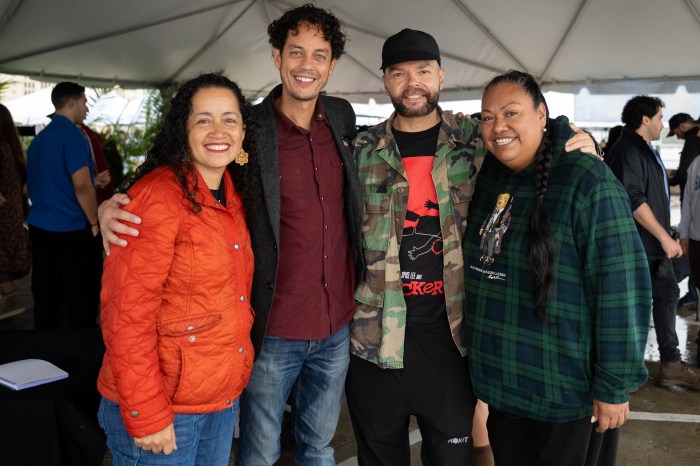Despite the dreary weather, New Yorkers gathered at Pier 4 of the Brooklyn Army Terminal on Sept. 28 to close out NYC Climate Week and celebrate the progress of climate justice since the 2014 People’s Climate March — the largest in U.S. history with over 300,000 participants.
The festival, titled “Climate Justice Lives Here!,” was hosted by UPROSE, Brooklyn’s oldest Latino community-based organization focused on environmental and social justice founded in 1966. The event featured cultural and musical performances, interactive learning circles such as clothing patchworking and mending workshops to reduce fashion waste, a native plants workshop, a seed bombing workshop, a diverse food bazaar, and art activities.
Elizabeth Yeampierre, executive director of UPROSE, told Brooklyn Paper the event also aimed to educate the public about UPROSE’s role in providing climate change solutions.
UPROSE’s achievements include the offshore wind facility at the South Brooklyn Marine Terminal in Sunset Park, which began construction in June and will provide clean electricity to 500,000 homes once completed. Another project, Sunset Park Solar, is New York City’s first cooperatively owned community solar project. Owned and operated in partnership with UPROSE and Working Power, the solar energy system will be built on the Brooklyn Army Terminal rooftop.


“I think that [Sunset Park] can be a model of what’s possible,” Yeampierre said. “So we wanted an event to celebrate that. Everybody’s in doom and gloom, and we’re saying, ‘Hey, you know what? Let’s dance, and let’s show what’s possible because we have solutions.'”
Council Member Alexa Avilés, a member of the council’s Committee on Environmental Protection, Resiliency & Waterfronts, told Brooklyn Paper the event was about addressing climate change and the transition to a just economy that benefits everyone. Climate change is here, Avilés said, and governments must take the climate emergency seriously.
“The message of this event is that there are solutions. This is not an insurmountable thing. It’s challenging, but it’s not insurmountable,” Avilés said. “We really need to lean into those solutions and invest in the solutions that we know are right rather than investing in false solutions or mechanisms that, quite frankly, don’t work.”
Recent weather disasters are not regular weather patterns, Avilés noted. Unprecedented flooding due to extreme rainfall in parts of Africa and Europe has killed thousands, while Hurricane Helene recently caused devastation across six U.S. states, claiming more than 100 lives.
Brooklyn Paper asked Avilés how to work with climate emergency deniers. She urged them to “open their eyes” and recognize the global consequences.
“This is a serious thing, and just open your eyes and see it, and we can actually probably turn the tide,” Avilés said. “We have to be behaving with the consideration of the next seven generations and making sure that they have a planet that is sustainable and that they can live in.”

Assembly Member Marcela Mitaynes (D-Brooklyn) told Brooklyn Paper that Sunset Park is a frontline community, and environmental justice is a key issue.
Mitaynes introduced a bill, the “Indirect Source Rule,” to tackle the issue of “last-mile warehouses”—the final stop for packages ordered online. These warehouses have been increasingly set up in frontline neighborhoods like Red Hook and Sunset Park.
“The problem with these facilities is that we don’t know how many trucks are coming in and out, and so that is adding to [air] pollution,” Mitaynes explained.
The bill aims to find a balanced solution for both residents and businesses, acknowledging the permanence of e-commerce.
“We need to figure out a way where we can co-live,” Mitaynes said. “We don’t want the businesses to go away. They’re providing jobs and income for the community. We want to figure out a way that we can co-live and co-work [and] everybody can benefit. There is a way we can live together, and that’s what we are going for.”


Louise Yeung, the chief climate officer with the New York City Comptroller’s office, participated in the clothing patchworking and mending workshop.
Around 11.3 million tons of clothing end up in U.S. landfills annually, and the fashion industry contributes 1.2 billion tons of carbon dioxide to the atmosphere, worsening the climate crisis.
The workshop taught attendees how to revitalize their favorite garments rather than dispose of them. Yeung brought a shirt she had purchased at a thrift store years ago that was “pretty tattered.”
“I was really excited to learn how to mend this garment so I can wear it longer,” Yeung told Brooklyn Paper. “This is my first time mending. I’m so excited.”
Shelby Luster, a resiliency planner with UPROSE, led a workshop on creating seed bombs—a guerrilla gardening technique used to regreen urban and neglected areas. Seed bombs help prevent soil erosion, provide habitats for wildlife, and enhance ecosystems by increasing biodiversity.
“Seed bombs were invented by Japanese biologist Masanobu Fukuoka as a way to regreen spaces without a lot of machinery, in a way that’s really easy to make and doesn’t involve any pollution in the environment, and very little labor,” Luster said. “It is an easy way to regreen areas.”


Participants mixed red clay powder, soil or compost, and water, then added seeds like Swamp Milkweed, Joe Pye Weed, and Tussock Sedge for rain garden seed bombs to prevent flooding, or New England Aster, Wild Geranium, and Butterfly Weed for native wildflower bombs to beautify their neighborhoods.
“They are really hearty seeds that can really latch on without too much propagation, which is the whole point — you throw the bomb, and then it just kind of does its thing,” Luster said.

























